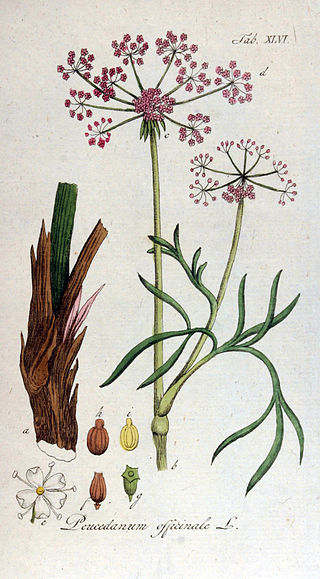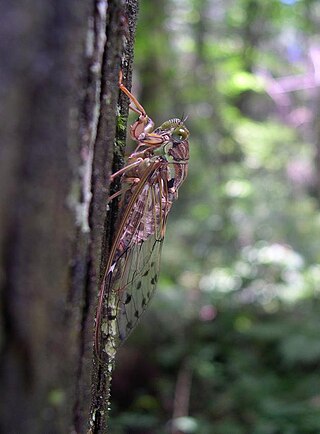Semia is a genus of Asian cicadas in the tribe Cicadini, erected by Matsumura in 1917.

The rove beetles are a family (Staphylinidae) of beetles, primarily distinguished by their short elytra that typically leave more than half of their abdominal segments exposed. With over 66,000 species in thousands of genera, the group is the largest family in the beetle order, and one of the largest families of organisms. It is an ancient group, with fossilized rove beetles known from the Triassic, 200 million years ago, and possibly even earlier if the genus Leehermania proves to be a member of this family. They are an ecologically and morphologically diverse group of beetles, and commonly encountered in terrestrial ecosystems.
The Catalogue of Life is an online database that provides an index of known species of animals, plants, fungi, and microorganisms. It was created in 2001 as a partnership between the global Species 2000 and the American Integrated Taxonomic Information System. The Catalogue is used by research scientists, citizen scientists, educators, and policy makers. The Catalogue is also used by the Biodiversity Heritage Library, the Barcode of Life Data System, Encyclopedia of Life, and the Global Biodiversity Information Facility. The Catalogue currently compiles data from 165 peer-reviewed taxonomic databases that are maintained by specialist institutions around the world. As of September 2022, the COL Checklist lists 2,067,951 of the world's 2.2m extant species known to taxonomists on the planet at present time.

Peucedanum is a genus of flowering plant in the carrot family, Apiaceae. Peucedanum boasts a global presence with diverse spread of morphological features. Peucedanum species are characterized by dorsally compressed mericarps, slightly prominent dorsal ribs, narrowly winged lateral ribs, and a broad commissure. However, the vast diversity of morphology, fruit forms, and phytochemical production makes classifying species in the Peucedanum challenging. Historically relevant in traditional medicine, Peucedanum's taxonomic complexity arises from its extensive diversity.
The World Register of Marine Species (WoRMS) is a taxonomic database that aims to provide an authoritative and comprehensive list of names of marine organisms.

Tanna is a genus of cicadas from Southeast Asia and East Asia. In 2010 Lee and Hill placed Tanna in the subtribe Leptopsaltriina, which is now in the tribe Leptopsaltriini together with a number of related genera that also possess abdominal tubercles, including Leptopsaltria, Maua, Nabalua, Purana, and others.
Rubellia is a genus of grasshoppers described by Carl Stål in 1875, in the tribe Sphenariini and monotypic subtribe Rubelliina. It appears to be monotypic, containing Rubellia nigrosignata. It is endemic to the island of Madagascar.

Pyrgomorphidae is a family of grasshoppers in the order Orthoptera; it is the only family in the superfamily Pyrgomorphoidea. Pyrgomorphidae is found worldwide in tropical and warm temperate regions, but the vast majority of the family's approximately 500 species are from Africa, Asia and Australia. Their name is probably derived from pyrgos meaning "tower": a reference to the form (morph) of the head in the type genus Pyrgomorpha and other genera.
Chotekia is a genus of seed bugs in the tribe Drymini, erected by China in 1935. The genus contains the single species Chotekia typica.

Tachyporus dispar is a species of rove beetle from Tachyporinae subfamily that can be found in Czech Republic, Slovakia, and throughout Western Europe.
Chamus is a genus of Miridae or capsid bugs in the tribe Dicyphini and subtribe Odoniellina. Species can be found in central and southern Africa, with the type C. wealei first described by Distant in 1904.

Scymnus is a genus of beetle in the family Coccinellidae. It is the type genus of the subfamily Scymninae and the tribe Scymnini.
Amulius is a genus of Asian bugs in the family Reduviidae. It has been placed in the tribe Ectinoderini: the 'Oriental resin bugs'.

Ectinoderus is a genus of Asian bugs in the family Reduviidae. It is the type genus of the tribe Ectinoderini: the 'Oriental resin bugs'.
Salvazana is a monotypic genus of Asian cicadas in the tribe Cryptotympanini. The single species Salvazana mirabilis is recorded from Indochina: to date, specifically Thailand and Vietnam.
Acanthodelphax is a genus of mostly European planthoppers belonging to the tribe Delphacini.

Pedum is a monotypic genus of bivalves belonging to the family Pectinidae. The only species is Pedum spondyloideum and it is the only genus in the tribe Pedini.
Sahlbergella is a genus of African bugs in the family Miridae and tribe Dicyphini.
Distantiella is a genus of African bugs, of the family Miridae or "capsids", named after William Lucas Distant. This genus is placed in the subtribe Odoniellina: which has been included in tribes Dicyphini or Monaloniini.

Cicadatra is a genus of European and Asian cicadas; it was erected by Kolenati in 1857 and is typical of the tribe Cicadatrini.











